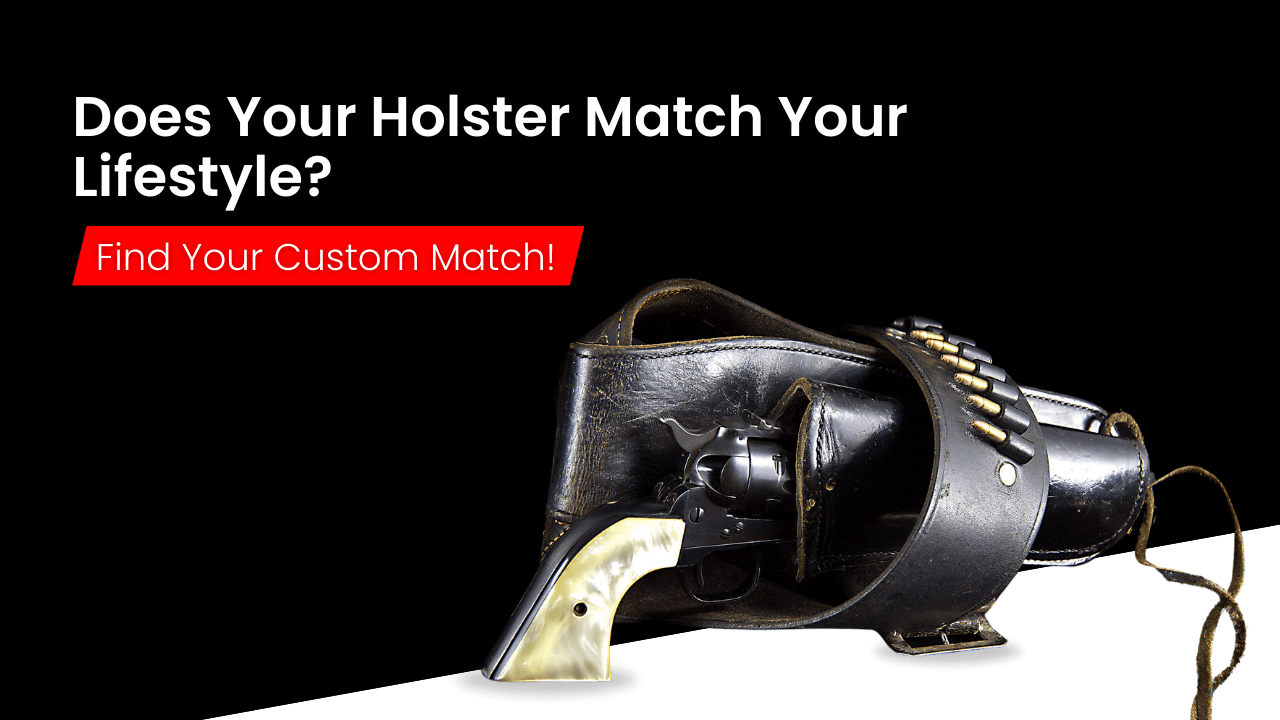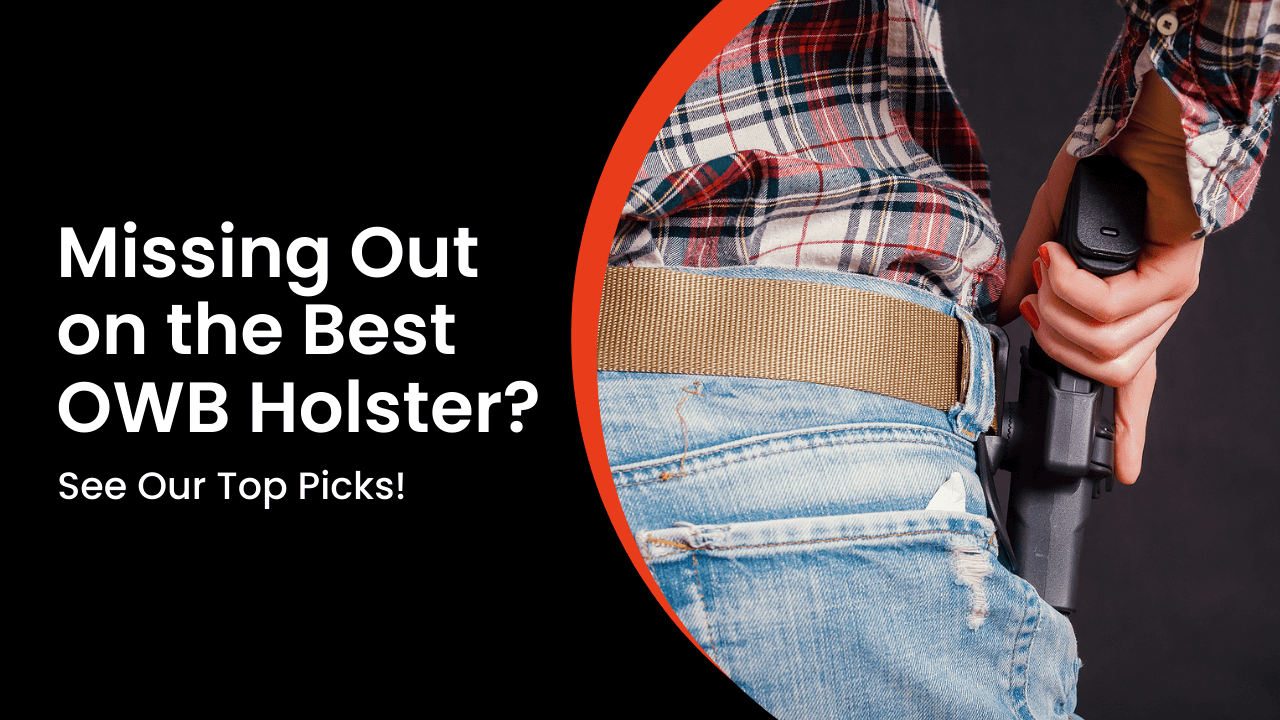A Comprehensive Guide for Choosing a Car Gun Holster
Mar 20th 2023
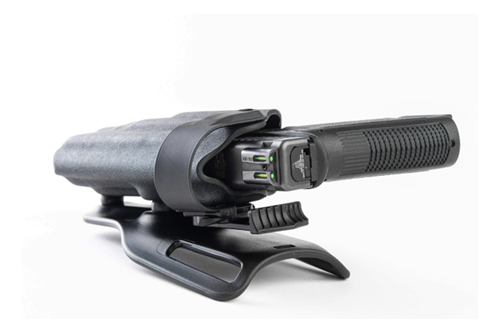
Although manageable for shorter trips, wearing your standard body-worn gun holster may not be the most comfortable concealed carry solution when spending extended periods in your vehicle.
If you are a concealed carry enthusiast and a frequent driver, you may have asked yourself, “What is the best holster for a car?” Find out what a car gun holster is, what benefits it offers to gun owners, how to choose the best one for your needs, and what practical and legal aspects to consider.
Definition of Gun Holsters for Cars
The purpose of a car gun holster is to hold your firearm securely in your vehicle. These holsters are made from various materials, such as leather, nylon, or Kydex. They are designed for mounting in different locations within your vehicle for quick and easy access from the driver’s seat.
Importance of Gun Holsters for Cars
Using a gun holster for cars is practical because it is an efficient way to carry a handgun in your vehicle without using a holster on your body, which can be uncomfortable, especially during long rides.
While modern, high-quality standard body-worn holsters are designed for comfortable everyday carry , they are primarily intended for use while standing. A car gun holster is designed for use by a gun owner in the driver’s seat, providing them with a safe and easy-to-reach place to draw and store a handgun and minimizing the risk of traffic accidents and negligent discharges.
Additionally, certain jurisdictions may require you to keep loaded firearms hidden from view. While traditional solutions such as storing your gun in the glove box or under-seat compartments can help you keep it hidden, they provide no retention or safety, potentially causing your weapon to slide or move out of place.
A quality car gun holster lets you comply with local laws and keep it concealed from outside view while keeping your gun safe and secure in one place.
Benefits of Using Gun Holsters for Cars
Gun owners can benefit from using car gun holsters in three primary ways: accessibility, safety, and protection from theft.
Enhance Safety
Gun holsters are safety devices. Their primary purpose is to securely store your handgun when not in use, protecting your trigger guard and keeping it in one place, pointed in a safe direction.
A car gun holster has the same essential purposes but is adapted for safely carrying pistols and revolvers in a vehicle. It reduces the risk of an accidental discharge and prevents your handgun from moving or sliding around while driving.
Increased Accessibility
While standard gun holsters keep your firearm secure when not in use, they must also present it in the correct orientation for you to reach and draw quickly. Choosing the right holster for your vehicle ensures you can draw and re-holster a firearm safely from the driver’s seat without requiring you to bend in uncomfortable positions.
Protection from Theft
A properly mounted and concealed gun holster can help keep your firearm hidden from view and deter potential thieves and other unauthorized individuals from stealing your gun.
Key Considerations Before Selecting a Gun Holster for a Car
Gun holsters for cars can only efficiently fulfill their jobs if adapted to the shooter’s needs. They must also comply with all applicable local and state laws.
Holster Size
One of the most critical considerations is ensuring the holster is designed to fit your particular firearm model. Most holsters can only fit a specific gun model exclusively. In rare instances, a holster may fit small ranges of guns with similar dimensions. For example, a holster for Glock 32 can typically also fit a Glock 19 and a Glock 23 due to their identical external dimensions.
Using an ill-fitting car gun holster for your gun can make it either too small or too large for your weapon. A too-small holster makes inserting or drawing your gun needlessly difficult, if not impossible. If it’s too large, the holster fails to retain your gun properly, increasing the risk of it falling out while driving.
Access Points
Consider how you’ll access your gun when selecting a holster. Some holsters are designed for right-handed or left-handed access, while others can be adjusted for either hand. Think about where you’ll mount the holster and how you’ll reach for your gun in an emergency.
State and Federal Laws
Before purchasing a car gun holster, research the laws in your state and local jurisdiction. Some states and local entities have strict regulations on how gun owners can transport their firearms in vehicles, and you’ll want to ensure that the holster you choose helps you comply with local laws.
Additional Factors to Consider When Choosing a Car Gun Holster
When choosing the right car gun holster for your needs, additional considerations include the primary materials used in its construction, its durability, ease of maintenance, concealability, retention, and security features.
Materials and Durability
Like with IWB and OWB holsters, the material of your car gun holster plays a role in its durability and overall performance. Common materials include leather, nylon, and Kydex.
- Leather: Leather holsters are often considered the most comfortable and aesthetically pleasing option. They can mold to your firearm over time, providing a custom fit. However, the leather may require more maintenance than other materials and can be sensitive to moisture and temperature changes.
- Nylon: Nylon holsters are generally less expensive and more lightweight than their leather counterparts. They are also resistant to moisture and can be easily cleaned. However, nylon holsters may offer a different level of retention and rigidity than other materials.
- Kydex: Kydex is a rigid thermoplastic material that is highly durable, resistant to moisture, and easy to clean. Kydex holsters offer excellent retention and are often used by law enforcement and military personnel. While the rigid material can be considered less comfortable than leather or nylon, Kydex offers the best balance of durability, cost, and ease of maintenance, making it the top choice for car gun holsters.
Retention and Security
Part of a gun holster’s purpose is to provide adequate retention to your firearm. Retention can be passive or active:
- Passive retention keeps the gun in place with friction and the tightness of the holster’s shell. Holsters with adjustable retention let the shooter adjust how tightly or loosely the shell grips the firearm.
- Active retention systems are mechanical elements helping keep a handgun holstered, such as thumb breaks or locking systems. They must be manually engaged and disengaged to draw and re-holster the firearm. Active retention holsters are primarily used in law enforcement and military applications, where a high level of security prevails over ease of access.
Consider your personal preferences and the level of protection you require when selecting a car gun holster with the appropriate retention features.
Concealment
If discretion is your priority, consider choosing a car gun holster that offers adequate concealment. Under-seat and seat-mounted holsters with a cover can help keep your firearm out of sight from potential thieves or passengers. Some holsters are designed with low-profile features to minimize bulk and visibility when installed in your vehicle.
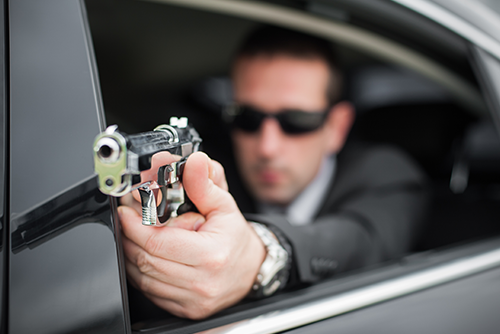
Mounting Points for Car Gun Holsters
Car gun holster types are differentiated by their mounting location in the vehicle. The four categories of car gun holsters are console-mounted, seat-mounted, under-seat, and door-mounted.
Console-Mounted Holsters
Console-mounted holsters attach to your vehicle’s center console, providing a secure and easily accessible location for your firearm. These holsters typically require little to no modification to your vehicle and are one of the most popular options for car gun storage.
Seat-Mounted Holsters
Seat-mounted holsters attach to the front of your vehicle’s driver or passenger seat. These holsters provide quick access to your firearm and can be easily concealed by a jacket or other item draped over the seat. Seat-mounted holsters may require minor adjustments to the seat itself but are generally easy to install.
Optional accessories such as seat holster covers can help gun owners comply with the law in jurisdictions requiring them to keep their guns hidden from public view in their vehicles.
Under-Seat Holsters
Under-seat holsters are designed to be mounted beneath the driver or passenger seat, providing a more discreet storage option for your firearm. These holsters are more challenging to access in an emergency but offer the benefit of added concealment.
Some jurisdictions require gun owners to keep guns in their vehicles concealed out of view, making under-seat holsters one of the most practical solutions to comply with local laws.
Door-Mounted Holsters
Door-mounted holsters attach to the inside of your vehicle’s door panel, providing quick and easy access to your firearm when you open the door. This type of holster can be an excellent option for those who want their gun to be immediately accessible when entering or exiting their vehicle.
How to Install a Gun Holster in Your Car
When installing a car gun holster, following the manufacturer’s installation instructions as closely as possible is critical. Here is a breakdown of the general steps you’ll need to follow.
Preparing the Gun Holster
Before installing your car gun holster, ensure it’s the correct size for your firearm and complies with all state and federal laws. You’ll also want to gather the necessary tools and mounting hardware to complete the installation.
Selecting the Position for the Holster
Choose a location for your holster that provides easy access to your firearm and complies with any legal requirements. Consider factors such as your dominant hand, how you’ll reach for your gun in an emergency, and whether the location will be easily visible to others.
How to Attach the Holster
Follow the manufacturer’s instructions for attaching the holster to your chosen location. Depending on the holster type, the attachment process typically involves using screws, bolts, or adhesive to secure the holster. Be sure to test the strength of the attachment to ensure that it will hold up under usual driving conditions.
Testing the Holster
Once your car gun holster is installed, test it by inserting and removing your firearm several times. Ensure the gun fits securely in the holster and you can easily access it. Adjust the holster as needed to ensure proper fit and function.
Maintaining Your Car Gun Holster
Proper maintenance is essential for ensuring the longevity and reliability of your car gun holster. Here are some tips for keeping your holster in top condition:
- Regularly inspect your holster for signs of wear or damage.
- Function-check the mounting hardware and retention devices and ensure all screws are properly tightened. Address any issues immediately to prevent potential safety hazards.
- Clean your holster periodically, especially if it’s exposed to dirt, dust, or moisture. Follow the manufacturer’s recommendations for cleaning and care, as different materials may require specific cleaning methods or products.
- If your holster has a retention adjustment screw, check and adjust it to maintain a secure fit for your firearm. This is particularly important if you frequently remove and reholster your gun, as the fit may change over time.
Holster Training and Practice
Make the most of your car gun holster and ensure you can access your firearm quickly and safely. Here are some tips for getting started:
Incorporate Holster Training and Practice into Your Regular Firearms Training Routine
Begin by practicing drawing from your car gun holster. Draw practice will help you familiarize yourself with the holster’s retention system and the unique draw stroke of a car gun holster.
Because practicing will require you to draw your gun from your car, always practice with an unloaded firearm and choose a safe environment away from public view. The inside of your garage is an example of a suitable place to practice car holster draw strokes.
Training Scenarios
Practice drawing your firearm from your holster in various positions and scenarios. These drills may include sitting in the driver’s seat, leaning across the console, or accessing your gun from the vehicle's passenger side. The more comfortable you are at drawing your firearm from different positions, the better prepared you’ll be in an emergency.
Train regularly to maintain your skills and proficiency. Like any other aspect of firearms training, practice is essential to ensure you can access and use your gun effectively.
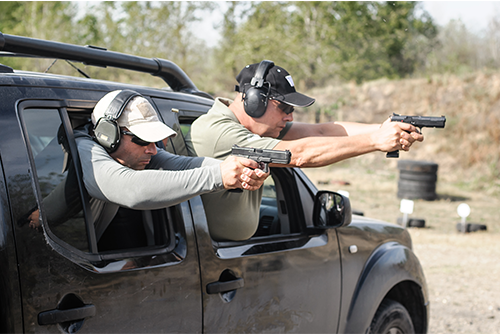
Live-Fire Training
Training drills with live ammunition are recommended to hone your drawing and shooting skills. However, practicing live-fire drills with your car gun holster can be challenging because the average shooting range lacks provisions for shooting from your car.
The best solution for practicing car gun holster drills with live ammunition is to visit a training facility teaching vehicle tactics. They can provide valuable tips and lessons on drawing, shooting, and maneuvering from a car and how best to use your car gun holster.
Legal Considerations and Staying Informed
As a responsible gun owner, staying informed about the laws and regulations governing the use and transportation of firearms in your area is essential.
Relevant laws and regulations include understanding the requirements for using a car gun holster and any restrictions that may apply to specific types of holsters or mounting locations.
For instance, as of April 2023, Michigan law does not explicitly address car gun holsters. However, the state does have regulations governing the transportation of firearms in vehicles.
If you possess a valid Michigan Concealed Pistol License (CPL), it is legal for you to carry a loaded and concealed handgun in your vehicle. In this case, using a car gun holster is generally considered acceptable so long as the firearm remains concealed.
If you do not have a CPL, you are subject to stricter regulations when transporting firearms in a vehicle. In this case, Michigan law requires gun owners to keep their guns unloaded and stored in a dedicated case.
Additionally, gun owners must store the gun case in a location that is not readily accessible to the vehicle’s occupants, such as the trunk. A standard car gun holster may not be a legally acceptable firearm transport method in this situation.
Shop High-Quality Custom EDC Holsters at Incognito Concealment
Whether you are new to concealed carrying or are a passionate Second Amendment enthusiast with an extensive gun collection, carrying your handguns in high-quality holsters designed for them is crucial.
Incognito Concealment produces a large selection of quality gun holsters that are 100% hand-crafted in the United States. Contact us to learn more about our products or concealed carry tips with our holsters.






